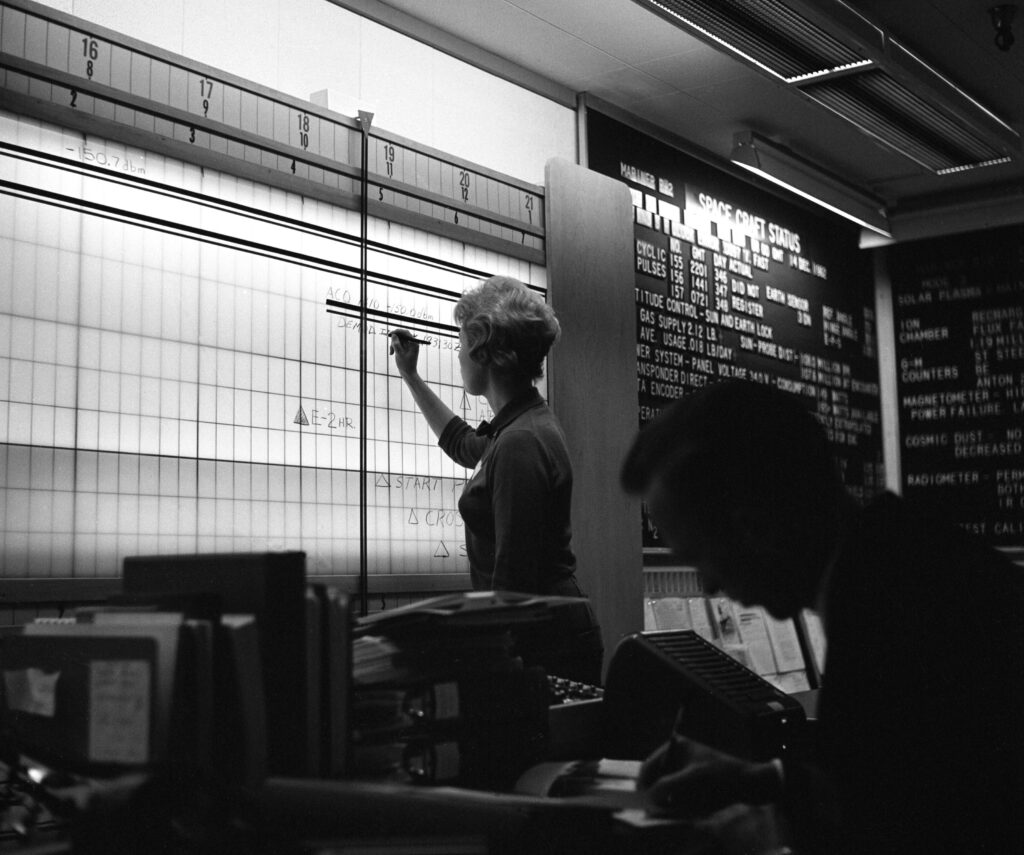Nathalia Holt. Rise of the Rocket Girls. Little, Brown, 2016. 352 pp. $27.
When I was a kid, my parents would pile my sisters and me into the minivan and drive us from big-sky Illinois to the red-clay foothills of northern Alabama for summer vacation. For a week my aunt, who lived in Huntsville, would spoil us with craft projects and elaborate desserts, and then, when the heat got too much for us, take us down to the Air and Space Museum. The museum included space capsules, rockets, and other artifacts of the U.S. space program, all of it just across the airfield by our aunt’s office.
One summer my sisters and I arrived in Alabama hell-bent on completing an astronomy Girl Scout badge, so our aunt took us to work with her at the Marshall Space Flight Center. We were ushered from cubicle-filled office to lab to control room by an engineer with firsthand experience of the significant roles women have played in the space program. This engineer was our aunt, who trained as a high-school math teacher but from the 1980s to the early 2000s worked as a systems engineer and sometimes project manager for the center. She built on the work of earlier women, known as “computers,” who did the math that got the U.S. space program off the ground and who developed the computer programs my aunt and her colleagues used to keep it airborne.
Nathalia Holt’s Rise of the Rocket Girls, about the history of NASA’s human computers at the Jet Propulsion Laboratory (JPL) in California, is one of a number of recent books on women working on space-related projects, a list that includes Margot Lee Shetterly’s Hidden Figures, which relates the story of African American women who worked as computers for NASA in Langley, Virginia, and Dava Sobel’s The Glass Universe, about the 19th-century Harvard Observatory computers who mapped and catalogued the stars. In style and thrust—highlighting women who played a significant and previously underacknowledged role in major scientific developments—Rise of the Rocket Girls is also reminiscent of Denise Kieran’s The Girls of Atomic City: The Untold Story of the Women Who Helped Win World War II.
Rise of the Rocket Girls focuses on the life stories of the women involved and eschews the typical redemptive narrative of women overcoming the odds and obstacles placed in their way by institutions run predominantly by men—though, perhaps inevitably, there are hints of that trope throughout Holt’s book. The narrative is signposted by scientific milestones, such as the fire that killed the astronauts aboard Apollo 1 and the successful landing on the moon: a woman’s calculations played a central role in every one of NASA’s space milestones. But the narrative also tracks milestones of more general American history, such as the assassinations of John F. Kennedy and Martin Luther King Jr. As a whole these benchmarks convey the impression that the computers played a role in something much larger than themselves, something worth remembering.
As JPL expanded to pursue not only rockets but also missiles, Frank Malina, the lab’s director from 1944 to 1946, promoted one of JPL’s original computers, Macie Roberts, to supervise the growing group of computers. Part of her new job was hiring and training staff, and for the next 30 years—at a time when there were few opportunities for women to pursue scientific careers—Roberts selected only women to fill the computers’ ranks. Her hiring practices were plain to those who read the employment postings. As one computer noted, “the fact that the job didn’t require a degree was code . . . that it was open to women.” Her successor, Helen Ling, continued the policy—though by the 1980s Ling’s hires all had advanced degrees in math, computer science, or engineering.
Holt writes the following about Barby Canright, one of JPL’s original computers, but it appears to be true of all the women depicted in this book:
At the time JPL was first hiring computers, they were doing a job their supervisors considered clerical work: in other words, women’s work. It was a meticulous task that required an acute attention to detail and the ability to figure complex calculations by hand, and the jobs were filled overwhelmingly by women. By the mid-1980s, however, the landscape of computer science had begun to shift. Researchers have linked the plummeting number of women entering computer science in the United States at the time to the rise of personal computers. These machines were marketed almost exclusively to boys, and for the past 30 years the narrative of men-as-computer-geeks has dominated the story of computing.

But the history of women as computers and calculators, code makers and code breakers reaches at least as far back as “Pickering’s Harem,” the pejoratively named group of about 80 women who in the second half of the 19th century worked with astronomer Edward Pickering at the Harvard College Observatory. They catalogued photographs, classified stars, and copied notes, all of which might be dismissed as clerical work, except it was these women, and Annie Jump Cannon in particular, who developed the Harvard spectral classification system adopted by the International Astronomical Union to classify stars.
Holt offers her readers a glimpse into the work computers did even before the existence of JPL and how that work changed over time. During World War I, computers calculated ballistics range; during the Great Depression they compiled the 28-volume Mathematical Tables Project, with its rows of logarithmic and other mathematical functions. In the early years of JPL the computers relied on these books, as well as on slide rules and Friden calculators, machines the size and shape of a typewriter but designed to calculate numbers rather than compose letters. Later computers attended IBM training schools and computer-programming courses to update their skills for use on the Burroughs E101 and other electronic computers. They also learned how to write and correct FORTRAN, a computer-programming language new in 1957, and to work with Cora, the name the human computers at JPL gave the IBM 1620, which entered service in 1960. Holt remarks that the women running the calculations were much more willing to embrace new tools than their male engineering counterparts, though the long-term human computers sometimes double-checked the electronic computers by hand-plotting routes, as computer Barbara Paulson did for the trajectory of the space probes sent to Mars as part of the 1970s Viking program. Later, human computers adapted to the introduction of personal computers and faster processors, though it was these tools that eventually displaced them.
While Holt acknowledges the ways in which gender made it difficult for women to pursue professional careers, she gives short shrift to the roles race and class played at a time when segregation was rarely challenged and women lacked economic opportunities and were expected to shoulder the lion’s share of child rearing.
In Holt’s story the computers at JPL are hardworking, adaptable women who check each other’s work and together find the right solutions to difficult problems. By cataloguing their contributions, challenges, and rewards at a time of great technological innovation, she preserves their stories and lets their scientific legacies speak for themselves. According to Holt, JPL still employs more women than any other department of the U.S. space program.
While neither my sisters nor I ended up as scientists, we have gone on from Girl Scouting to pursue science-adjacent careers in environmental justice, nursing, and at the history-of-science institution whose magazine published this review. Women like our aunt and her colleagues expanded our horizons, provided enough lift to get us through the atmosphere, and helped us chart our course for whatever star we chose.




